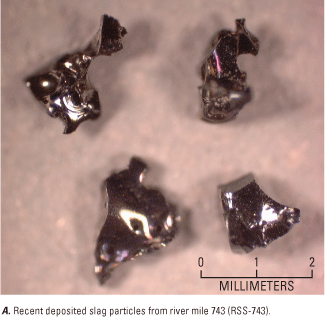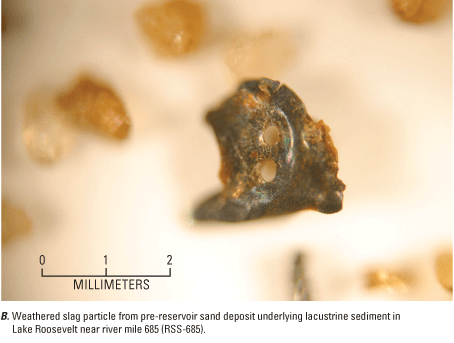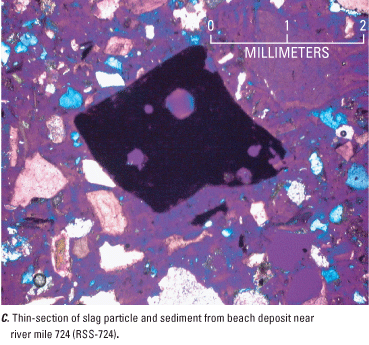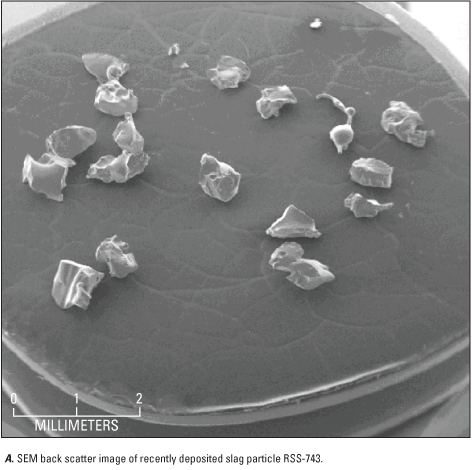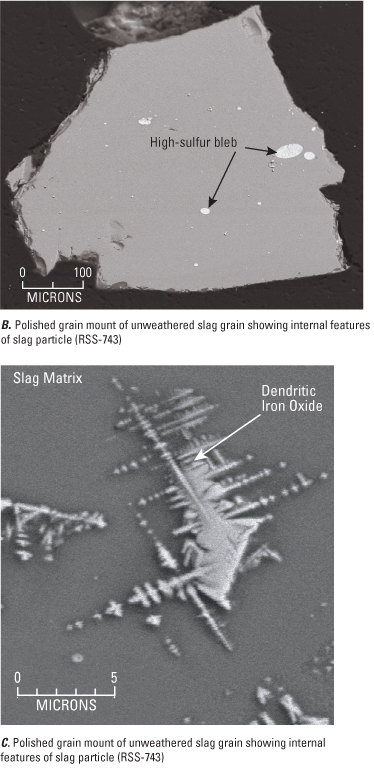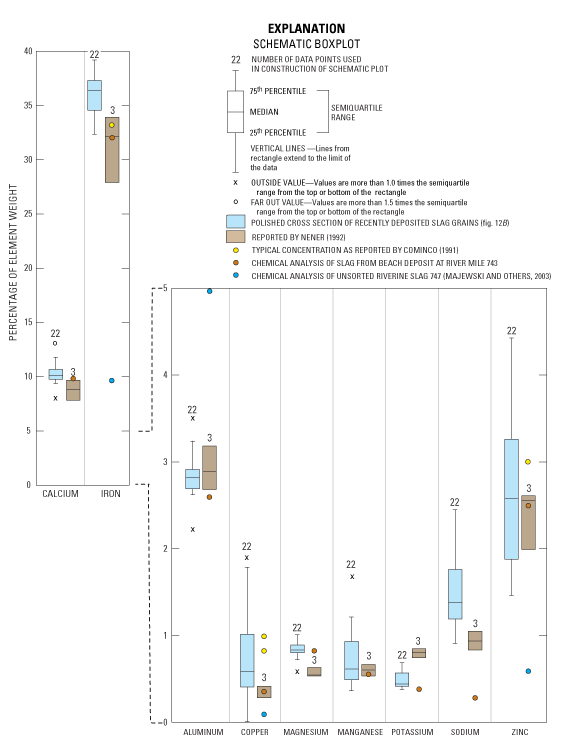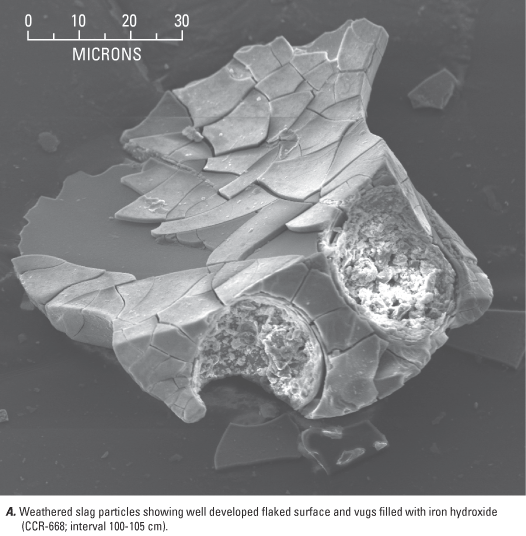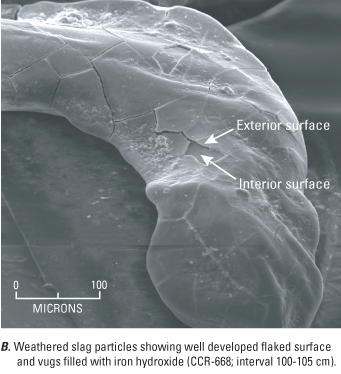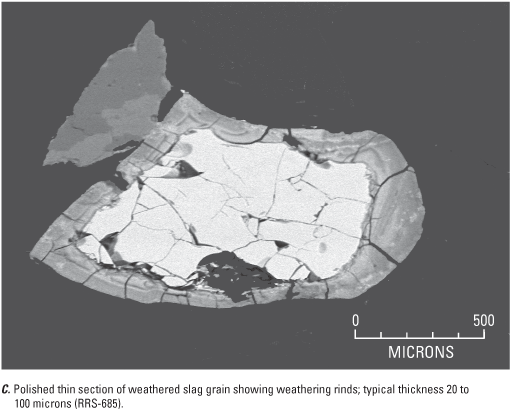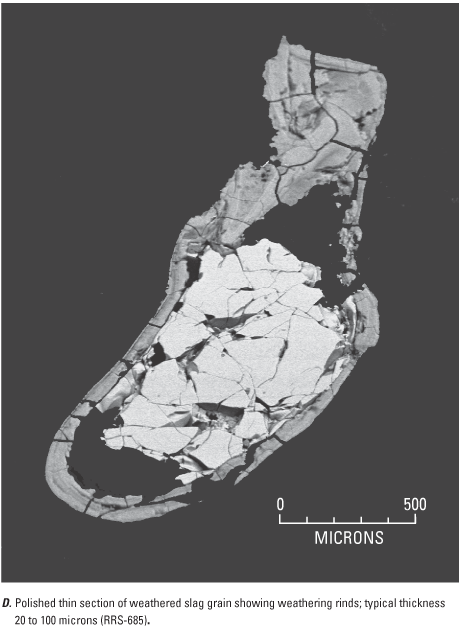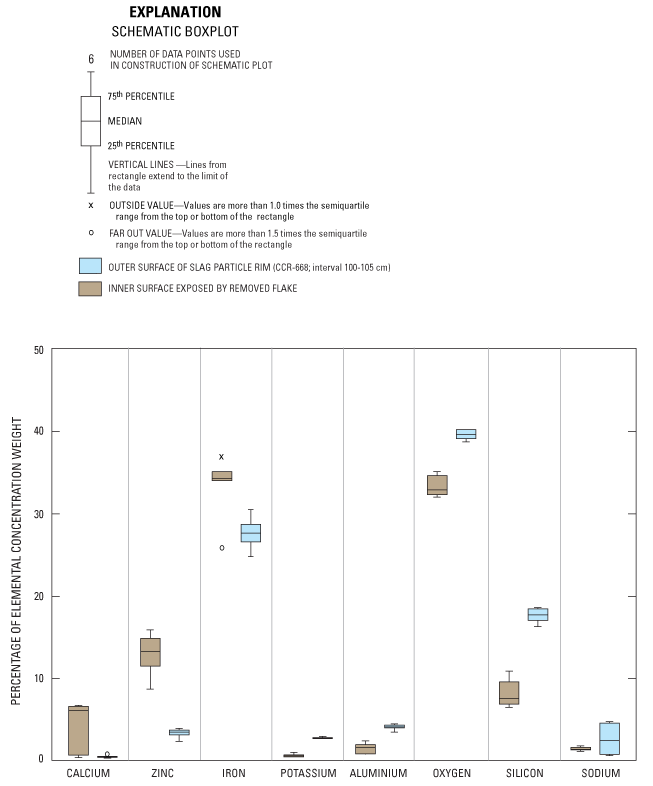U.S. GEOLOGICAL SURVEY
Scientific Investigations Report 2004-5090
Vertical Distribution of Trace-Element Concentrations and Occurrence of Metallurgical Slag Particles in Accumulated Bed Sediments of Lake Roosevelt, Washington, September 2002
Metallurgical Slag in Sediments of Lake Roosevelt
Slag particles have been widely deposited in the riverbed and along the banks of the upper and transitional reaches of Lake Roosevelt, particularly between Northport and the International Boundary. Slag particles make up from 70 to 90 percent by weight of the sand-sized particles of a black sand beach at RM 743 near the International Boundary (fig. 10). Particles of metallurgical slag have been found farther downstream in sediments of the Columbia River and Lake Roosevelt although easily identifiable slag grains diminish in number and size downstream of Northport. Slag particles can be readily distinguished from natural sediment grains of the Columbia River by a combination of distinctive morphology and physical features. The slag particles are sand size or smaller, black in color, and often have an iridescent sheen (fig. 11A). The surface texture of relatively unweathered particles is smooth, glassy, with a lustrous appearance while the surface of weathered grains has a dull-etched appearance. Slag particles have a distinctive morphology resulting from the combination of rounded and angular features often with needle-like projections, conchoidal fracture patterns, and small cavities or vugs (fig. 11B). Vugs generally are empty in unweathered particles while vugs in weathered particles are often filled with oxide precipitates, which may encrust much of weathered particles. Slag grains in thin section often contain large voids (fig. 11C); particles are opaque to transmitted light but may transition to amber at the extreme tip of pointed projections. The matrix of slag particles is a glassy calcium-iron-silicate with varying amounts of aluminum. Internal structures within the glassy matrix include various mineral phases and rounded metallic-sulfide blebs or prills (figs. 12A, 12B, 12C) containing copper or lead; with associated metals such as antimony and arsenic (Bart Canon, Microlab Northwest, Seattle, Washington, written commun., 2001). The density of slag particles varies, generally exceeding 2.9 g/cm3, however, some slag particles, which may have large voids, were observed floating on the water surface near the shore.
The general trace-element composition of slag discharged to the Columbia River is reported to vary considerably with typical concentrations of weight percent of <0.1 percent for lead, (<1,000 mg/kg); 3 percent for zinc (30,000 mg/kg); <0.01 percent cadmium (<100 mg/kg); and about 1 percent copper (10,000 mg/kg) (Cominco, 1991). G.J. Gawryletz (Cominco Ltd., written commun., 1998) reported substantially larger concentrations of zinc and lead, 12 and 2 percent, respectively, from residual slag deposits along the Columbia River following demolition of the slag launder and these concentrations were about three times larger than earlier reported concentrations. These data confirm that trace-element concentrations vary in Trail smelter slag.
Readily available reported chemical analysis of slag including elements other than the six trace elements of concern include the three analyses reported by Nener (1992) in which the slag was sampled prior to release to the environment. Majewski and others (2003) provided an analyses of 'riverine slag'; a sample collected along the riverbank containing both slag and natural river sediments. A similar sample collected from the beach at RM 743 (RSS-743) was analyzed for this study; the sample was sieved and sorted using a binocular microscope in an attempt to remove as much of the non-slag material as possible. Analysis of the sorted slag sample (RSS-743) is included in table 5 (after data for CCR-705).
The slag particles collected from a beach near the Columbia River International Boundary Auxiliary Gage at RM 743 is physically and chemically similar to the description of metallurgical slag discharged from the Trail smelter (Cominco, 1991). Bulk chemical compositions were determined for the polished interior surface of individual slag particles using a scanning electron microscope equipped with an energy-dispersive X-ray spectrometer (SEM/EDS). Median element-weight percentages of the slag determined by SEM/EDS were 37 for iron, 10 for calcium, 2.8 for aluminum, 2.6 for zinc, 1.3 for sodium, 0.8 for magnesium, 0.6 for manganese, 0.5 for copper, and 0.4 for potassium.
The SEM/EDS measurements of elemental concentrations RSS-743 matched closely the reported chemical analysis of slag discharged to the Columbia River by the Trail smelter (Nener, 1992) and the chemical analysis of the slag sample RSS-743 as shown in the boxplots in figure 13. The SEM/EDS analysis was determined from the measurement of 22 individual grains, whereas the elemental composition of slag from the Trail smelter was determined from an acid digest of three samples of fresh slag collected during a single day (Cominco, 1991; Nener, 1992). The comparison was limited to those elements determined by the SEM/EDS that were present in the sample at concentrations greater than 0.5 percent. The nine elements from all analyses were a close match considering differences in sample representation and methods of analysis (fig. 13). The close match between the suite of elements in the analysis of individual slag particles and bulk chemical analysis of slag also provided a method to confirm the identity of slag particles in downstream reaches of the reservoir.
Sediment particles isolated from selected sample intervals from the three upstream cores, CCR-668 interval 95-100; CCR-692 interval 30-32 cm, and CCR-705 interval 14-16 cm were classified as slag grains based on physical characteristics, density, and chemical composition. The largest particles, on the order of 1-2 mm that were most similar to those from the Columbia River sand bar at RM 743 (RSS-743), were from the interval 100-105 cm below the upper surface of CCR-668 (sediment-water interface). Slag particles in cores CCR-692 and CCR-705 were on the order of 0.05 to 0.1 mm, which was consistent with the predominant particle size of these sediments. The trace-element profiles for core CCR-668 indicate that the interval in which the slag particle was identified was in a section of the profile affected by landslides, thus, the slag in this interval likely was reworked material that had been transported to this area of the reservoir prior to construction of Grand Coulee Dam. Although these particles had similar color, shape, and optical properties to slag material from the gage location at RM-743, the surface appearance typically was more weathered, without the glassy-lustrous appearance, but retained some of the iridescent sheen.
The chemical composition determined by SEM/EDS of the surface of slag particles from core CCR-668 closely matched the slag particles from the recent beach deposit (sample RSS-743) except that the concentration of calcium typically was lower by as much as 70 percent in slag from core CCR-668 (fig. 14). Further SEM examination showed that the concentration of calcium on the surface of the slag particles from RSS-743 was intermediate between the relatively unweathered composition determined for the interior matrix of slag from RSS-743 and weathered surface of slag particles that had been buried with the reservoir sediments for some 20 to 40 years.
Figure 10. Black sand beach composed of 70 to 90 percent slag particles deposited near Columbia River gaging station at river mile 743, Washington.
Figure 11. Slag particles (RS-743) identified in sediment from Lake Roosevelt and the upper Columbia River, Washington.
Figure 11.—Continued
Figure 11.—Continued
The decrease in calcium is consistent with weathering of basaltic-volcanic glass, as calcium is often the most readily leached major element from basaltic glass (Eggleton and others, 1987). Calcium was determined to be selectively mobilized from massive lead-zinc slag exposed to natural weathering in Czechoslovakia for more than 100 years (Ettler and others, 2001). The surface texture and morphology, observed by SEM, of slag-like particles from the core sediments were marked by a flaky appearance and the precipitation of iron-oxide (figs. 15A and 15B). The dimensions of the surficial flakes typically were 20 to 50 microns across and 2 to 5 microns thick and likely result from the development of exfoliation lamina on the surface of slag particles caused by the hydration of glassy slag material as described by Freidman and others (1966) and Morganstein and others (1999).
Glassy slag deposited in the sediments of Lake Roosevelt shows definite signs of undergoing hydration and chemical weathering, rather than being chemically stable as described by Cominco (1991). Fourteen of eighteen slag grains from core CCR-668 that were examined with just the SEM showed signs of surficial weathering by the development of exfoliation flakes (figs, 15A-15D). There also were differences in the chemical compositions of the interior and exterior surfaces of the weathered slag material (fig. 16). SEM/EDS was used to measure the chemical composition of six locations on an interior surface exposed by the removal of an exfoliation flake and exterior surfaces of the slag grain shown in figure 12B. On the interior surface where the flake had been removed, the concentrations of calcium, iron, and zinc were larger compared to the outer surface. Concentrations of silicon, oxygen, potassium, aluminum, and sodium were higher on the exterior surface than on the interior surface. The distribution of these elements is consistent with weathering processes as calcium and iron are often mobile elements removed during chemical weathering while silicon, aluminum, and oxygen are more recalcitrant elements whose concentrations become larger in the residual weathered material. Further evidence of slag weathering is the development of weathering rinds, typically about 20 to 100 microns thick, as shown in slag grains below the lacustrine sediments south of French Rocks, RSS-685 (figs. 15C and 15D). Weathering rinds were not observed in the polished cross section of the unweathered slag particles collected from the beach deposit near the gage site at RM 743 (RSS-743) (fig. 12B).
Figure 12. Scanning electron microscope (backscatter images) of unweathered slag particles from Lake Roosevelt, Washington.
Figure 12.—Continued
Figure 13. Trace-element concentrations determined by SEM/EDS of slag particle (sample RSS-743) and reported concentrations from previous studies determined by acid digestion and instrumental analysis, Lake Roosevelt, Washington.
Figure 14. Trace-element concentrations determined by SEM/EDS of recently deposited slag particles and slag grains from core sediments, Lake Roosevelt, Washington.
Figure 15. Scanning electron microscopic (backscatter images) of weathered slag particles from Lake Roosevelt, Washington.
Figure 15.—Continued
Figure 15.—Continued
Figure 15.—Continued
Figure 16. Trace-element concentrations determined by SEM/EDS of outer surface of slag particles and inner surface exposed by removal of exfoliation flake, Lake Roosevelt, Washington.
For more information about USGS activities in Washington, visit the USGS Washington District home page .


